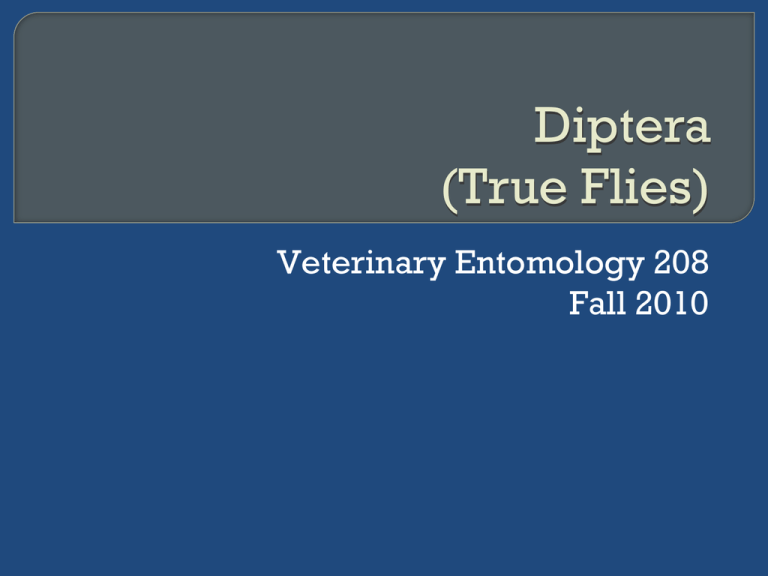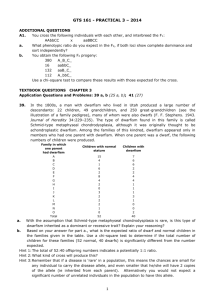
Diptera
(True Flies)
Veterinary Entomology 208
Fall 2010
Fly taxonomy
Traditional classification:
Brachycera
(‘short horn’)
• fat-bodied flies
• short antennae
• Examples: horse flies, house flies, etc.
Nematocera
(‘thread horn’)
• slender-bodied flies
• long, slender antennae
• Examples: gnats, mosquitoes, crane flies
Brachycera
Adults: taxa to know in key
•
•
•
•
•
•
•
•
Hippoboscidae (keds)
Tabanidae (horse flies, deer flies)
‘horse fly’
‘deer fly’
Calliphoridae
Cochliomyia sp.
‘calliphorid spp.’
Muscidae
Stomoxys calcitrans (stable fly)
Haematobia irritans (horn fly)
Musca domestica (house fly)
Musca autumnalis (face fly)
Key characters and taxa
Hippoboscidae
• wings absent
• tick-like in
appearance
www.dkimages.com
Key characters and taxa
Antennae
• aristate
• stylate (Tabanidae)
Tabanidae
horse fly
deer fly
(no specimens on exam)
Key characters and taxa
spiracle
bristle row
hypopleuron
Hypopleural bristles
• present
(Calliphoridae)
• absent
(Muscidae)
Calliphoridae
Cochliomyia sp.
calliphorid spp.
Key characters and taxa
Mouthparts
• piercing
• sponging (Musca)
palps
palps short
palps long
Stomoxys calcitrans
Haematobia irritans
parafrontal area
intermediately wide
very wide or very narrow
Musca domestica
Musca autumnalis
Brachycera
Larvae: taxa to know in key
•
•
•
•
•
•
•
•
Oestridae (botflies, cattle grubs)
Gasterophilus sp. (horse bots)
Hypoderma sp. (cattle grubs)
Calliphoridae (blowflies, screwworms)
Cochliomyia hominivorax (primary screwworm)
‘calliphorid spp.’ (blowflies)
Muscidae (house fly, stable fly, horn fly, face fly)
Stomoxys calcitrans (stable fly)
Haematobia irritans (horn fly)
Musca domestica (house fly)
Musca autumnalis (face fly)
larvae shape
small and slender
large and robust
other Brachycera
Oestridae
Oestridae
heavy spines
Gasterophilus sp.
spines small or absent
Hypoderma sp.
slits of posterior spiracles
straight
sinuous (squiggly)
Calliphoridae
Muscidae
Calliphoridae
Posterior tracheal trunks
pigmented, visible
Cochliomyia
hominivorax
Posterior tracheal trunks
unpigmented, not visible
calliphorid sp.
Muscidae
spiracles widely separated,
button centrally located
Stomoxys
calcitrans
spiracles proximate, button
laterally located
other Muscidae
Muscidae
spiracle with outer margin
dark, ring-like
entire spiracle dark, without
well-defined, dark margin
Musca domestica
other Muscidae
Muscidae
15 mm
7 mm
Musca autumnalis
Haematobia irritans
Culicidae adults
Taxa to know in key to adult females
Aedes
Anopheles
Culex
Culiseta
Psorophora
Toxorhynchites
palp length
as long as proboscis
short
Anopheles
other Culicidae
proboscis shape
slender and curved ventrad
apically
same diameter throughout,
straight
Toxorhynchites
other Culicidae
bristles
spiracular bristles present,
post-spiracular bristles present
spiracular bristles present,
post spiracular bristles absent
Psorophora
Culiseta
bristles
spiracular bristles absent, postspiracular bristles present
spiracular bristles absent, postspiracular bristles absent
Aedes
Culex
bristles
spiracular bristles
post-spiracular
bristles
Psorophora
+
+
Culiseta
+
–
Aedes
–
+
Culex
–
–
Culicidae larvae
Taxa to know in key to larvae
Aedes
Anopheles
Culex
Culiseta
Psorophora
air tube
absent
present
Anopheles
other Culicidae
air tube pecten
• comb-like
arrangement of
setae
• positioned near
base of tube
• all species included
in lab have pecten
air tube setal tufts
basal tuft absent, other tufts
present
basal tuft present, other tufts
absent
Culex
Culesita
anal segment
plate complete as a ring around
segment
plate not complete as a ring
around segment, forming ‘saddle’
Psorophora
Aedes









